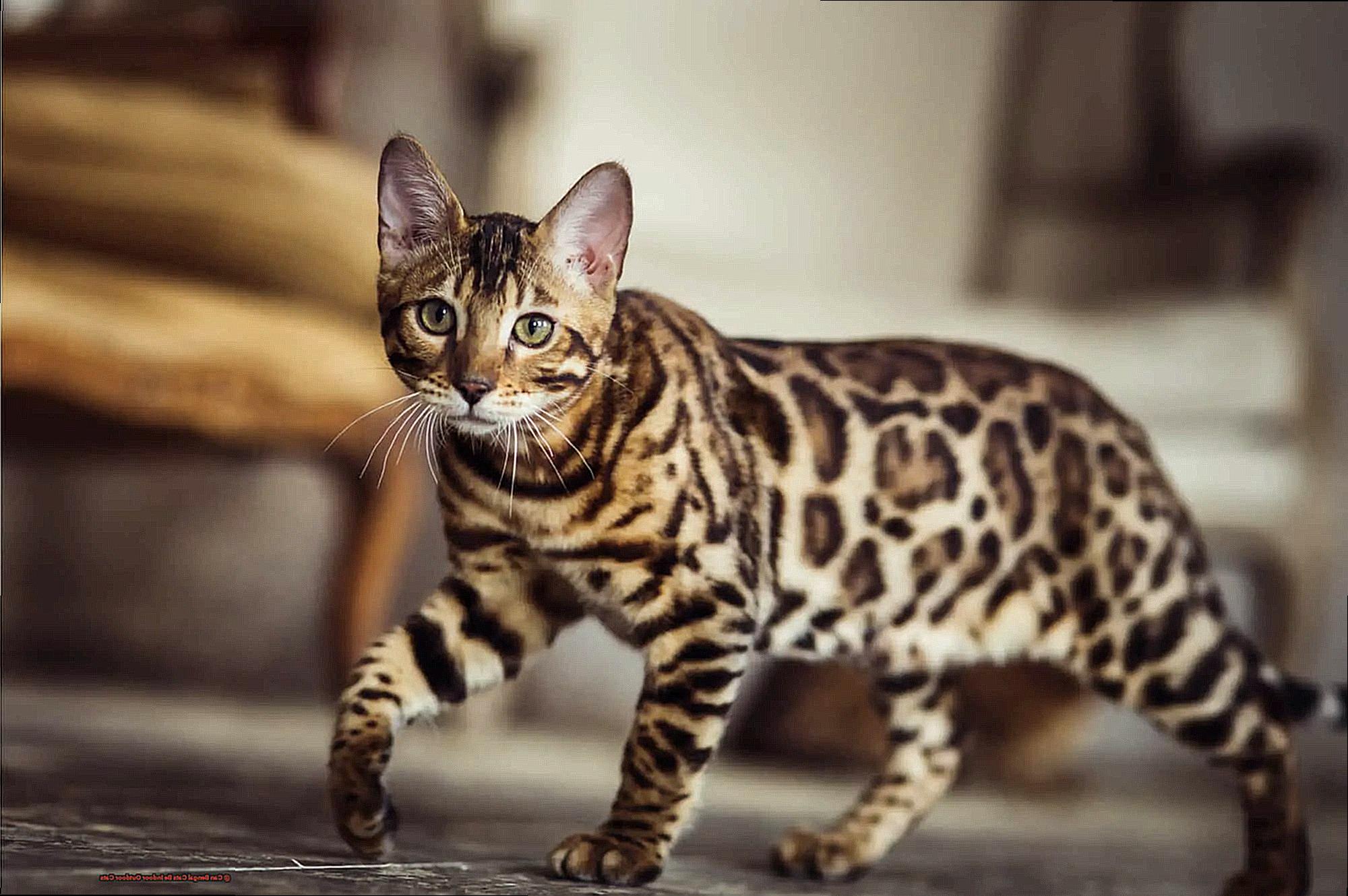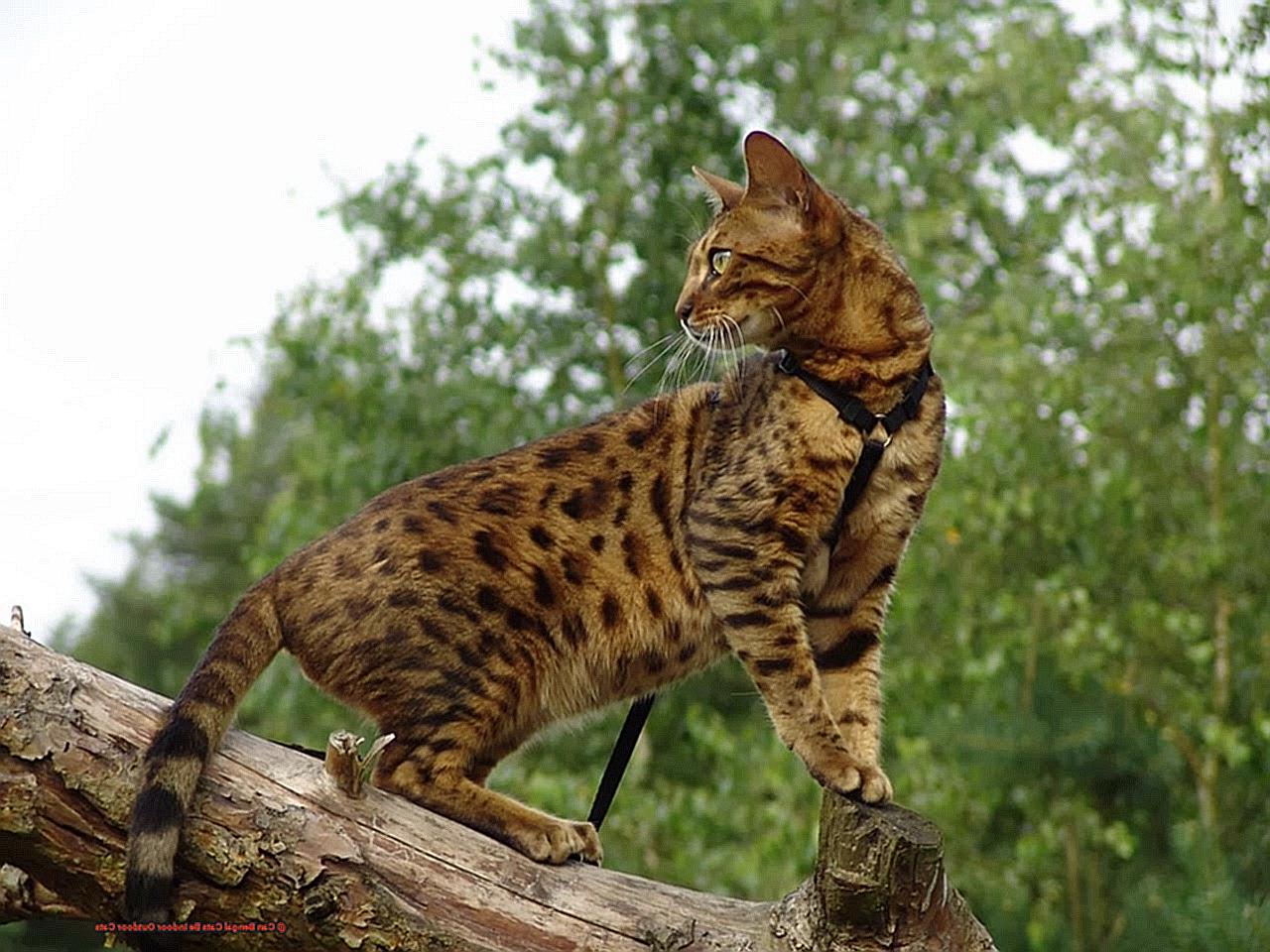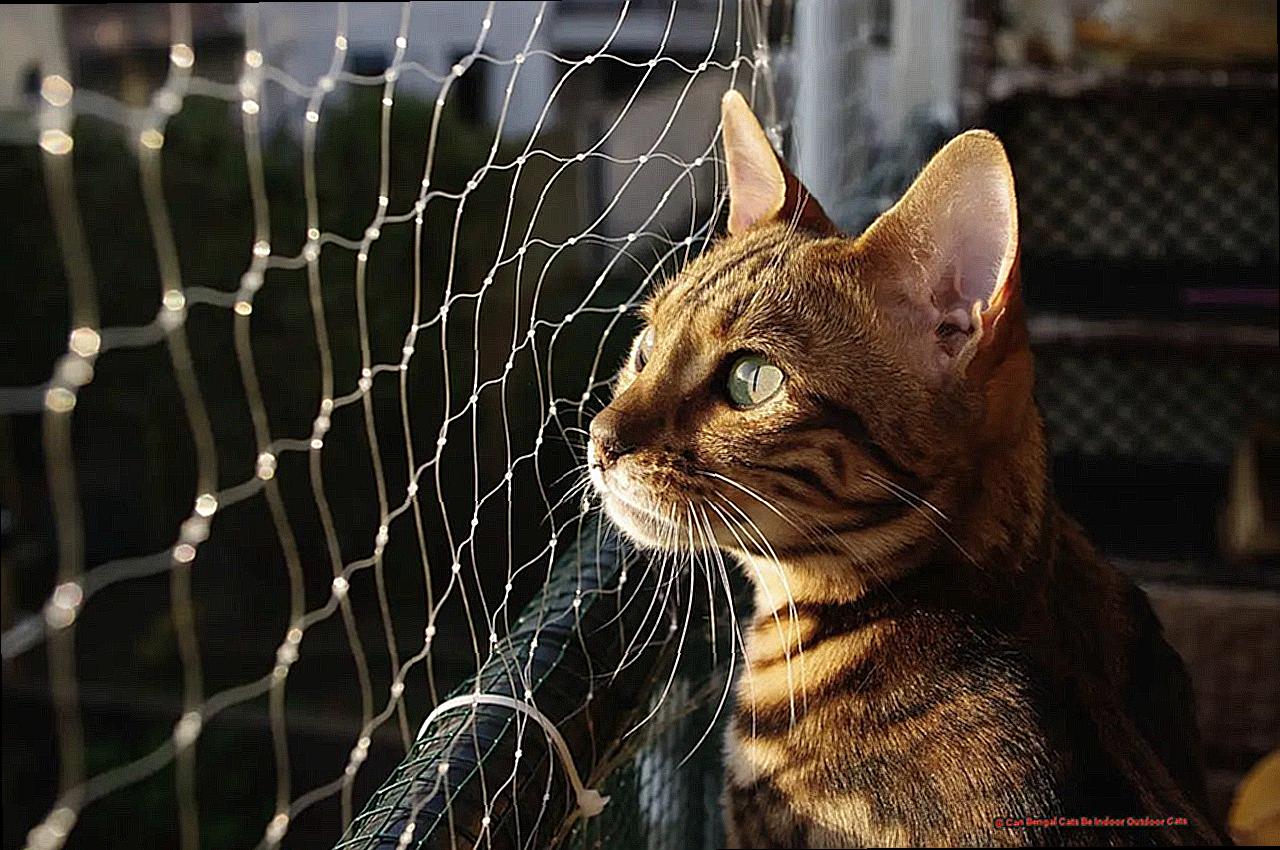Step into the world of Bengal cats, where their mesmerizing coat patterns and mischievous personalities have captivated the hearts of cat lovers far and wide. As a proud owner of one of these majestic creatures, you may find yourself contemplating whether your feline companion can revel in the best of both worlds as an indoor-outdoor cat.
The decision to let your Bengal roam freely outside is not one to be taken lightly, as it requires careful consideration of both the potential risks and rewards.
In this blog post, we embark on a journey to uncover the truth behind allowing your Bengal cat to explore nature’s playground while still relishing the comforts of indoor living.
Can Bengal cats be indoor outdoor cats
Bengal cats are a unique breed known for their wild appearance and active nature. They have a strong desire to explore and be outdoors due to their ancestry as descendants of Asian leopard cats. However, allowing Bengal cats to roam freely outdoors can pose certain risks. So, can Bengal cats be indoor-outdoor pets? Let’s examine the pros and cons.
Pros of Allowing Bengal Cats to Be Indoor-Outdoor Pets:
- Outdoor Stimulation: Bengal cats thrive on outdoor stimulation. Exploring the sights, smells, and sounds of the natural environment can provide mental and physical enrichment for them.
- Exercise and Hunting Opportunities: Outdoor exploration allows Bengal cats to engage in natural behaviors like climbing, running, and hunting. This helps them burn off excess energy and satisfy their innate instincts.
- Fresh Air and Sunlight: The outdoors offers fresh air and natural sunlight, which can contribute to a cat’s overall well-being. Sunlight is also essential for vitamin D synthesis.
Cons of Allowing Bengal Cats to Be Indoor-Outdoor Pets:
- Safety Concerns: Bengal cats face various risks when allowed to roam freely outdoors. Traffic accidents, encounters with predators or aggressive animals, and exposure to diseases are potential dangers they may encounter.
- Getting Lost or Stolen: Outdoor access increases the chances of a Bengal cat getting lost or stolen. This can be distressing for both the cat and its owner.
- Environmental Hazards: Outdoor environments may contain toxic plants, chemicals, or other hazards that could harm a Bengal cat if ingested or exposed to.
Finding a Balance:
To strike a balance between their need for outdoor stimulation and their safety, many Bengal owners opt for supervised outdoor experiences or create secure outdoor enclosures called “catios.” These enclosures provide a safe environment where Bengal cats can enjoy the outdoors while remaining protected from potential dangers.
Indoor Enrichment:
Whether indoor or outdoor, Bengal cats require mental and physical stimulation. Engaging in interactive play sessions, providing climbing structures, and offering puzzle toys can help keep them mentally stimulated indoors. Scratching posts, vertical spaces like cat trees, and interactive toys can mimic the outdoor experience as much as possible.
Pros and Cons of Letting Bengal Cats Explore Outdoors
Bengal cats are known for their high energy levels and curiosity, making them excellent candidates for outdoor exploration. However, there are both pros and cons to consider when deciding whether to let your Bengal cat explore the great outdoors.
Pros of Letting Bengal Cats Explore Outdoors:
- Mental Stimulation: Allowing Bengal cats to explore outdoors provides them with new sights, sounds, and smells, which can help stimulate their minds and prevent boredom.
- Natural Hunting Instincts: Outdoor exploration allows Bengal cats to fulfill their natural hunting instincts by chasing insects, birds, and small prey. This can provide them with both physical and mental exercise.
- Exercise and Health: Bengal cats are agile climbers and jumpers, and outdoor spaces offer them opportunities to climb trees and explore high places. This increased exercise can contribute to their overall health and well-being.
- Behavior Control: Outdoor exploration can help prevent boredom and destructive behavior in Bengal cats, as they have more outlets for their energy. This can lead to a happier and better-behaved cat indoors.
- Bonding Time: Some Bengal owners argue that letting their cats roam outside helps foster a stronger bond between the cat and the owner, as they spend more quality time together in nature.
- Stress Reduction: Outdoor exploration can offer Bengals a break from the confines of indoor spaces, reducing potential stress and anxiety.
Cons of Letting Bengal Cats Explore Outdoors:
- Safety Risks: Outdoor environments pose various risks to Bengal cats, such as traffic accidents, exposure to diseases, encounters with aggressive animals or stray cats, and the potential of getting lost.
- Theft Risk: Bengal cats’ unique coat patterns make them targets for theft if left unattended in outdoor areas.
- Exposure to Harmful Substances: Outdoor exploration can expose Bengal cats to harmful substances like poisonous plants or chemicals commonly found in gardens or urban areas.
- Territorial Disputes: Bengals that roam outdoors may engage in territorial disputes with neighboring cats, leading to fights and potential injuries.
- Supervision and Safety: Letting Bengal cats explore outdoors requires careful supervision and consideration of their safety. Proper vaccinations, microchipping, and identification tags are essential in case they get lost.
Creating a Safe Outdoor Environment for Bengal Cats
In this blog post, we will guide you through the steps necessary to create a safe and secure outdoor haven for your Bengal cat.
Build a Secure Enclosure:
Investing in a catio or outdoor enclosure specifically designed for cats is the first step towards ensuring your Bengal’s safety. These enclosures typically feature sturdy wire mesh walls and a roof to prevent escape and keep other animals out. Reinforce the structure to withstand the agile climbing and jumping abilities of Bengals.

Enrich the Space:
Make the outdoor enclosure an engaging and stimulating environment for your Bengal cat. Install perches, shelves, and climbing trees to provide vertical space for exploration. Add toys, scratching posts, and hiding spots to keep them entertained while outdoors. Don’t forget to include fresh water sources and shaded areas to protect against dehydration and overheating.
Eliminate Potential Hazards:
Regularly inspect the enclosure for any potential hazards that could harm your Bengal cat. Remove toxic plants, chemicals, or sharp objects that may pose a risk. Bengals are known for their ability to squeeze through tight spaces, so ensure there are no holes or gaps that they could escape through.
Protect from External Threats:
Prevent encounters with predators or disease by avoiding peak predator activity times, such as dawn or dusk when wildlife is most active. Keep your Bengal’s vaccinations up to date and regularly deworm them to minimize the risk of diseases transmitted through contact with other animals.
Provide Adequate Supervision:
Even within a secure enclosure, it is important to supervise your Bengal cat while they are outdoors. This allows you to intervene if any dangers arise or if your cat shows signs of distress or illness. Supervision also strengthens the bond between you and your feline friend.
Supervising Your Bengal Cat When Outside
Bengal cats are known for their high energy levels and curiosity, making them ideal candidates for supervised outdoor activities. However, it is important to ensure their safety and well-being by providing proper supervision. In this section, we will explore the reasons why supervising your Bengal cat when they are outside is crucial.
- Safety First: Before allowing your Bengal cat to venture outside, it is essential to ensure that your yard or outdoor space is safe and secure. Check for any gaps in fences or potential escape routes to prevent them from wandering off or getting lost.
- Accidents and Encounters: Supervision is crucial to prevent any accidents or encounters with other animals. Keep a close eye on your cat and make sure they do not wander too far from your sight. This will help protect them from potential dangers such as traffic or confrontations with other animals.
- Leash or Harness: It is recommended to keep your Bengal cat on a leash or harness while outside. This provides you with better control and prevents them from running off or getting into potentially dangerous situations. A leash or harness also allows you to guide them away from any potential hazards and keep them close to you.
- Gradual Introductions: Introduce your Bengal cat to the outdoors gradually. Start with short, supervised sessions and gradually increase the duration as they become more familiar with the surroundings. This helps them adjust to the new environment and reduces the risk of them becoming overwhelmed or frightened.
- Enrichment Activities: Provide enrichment activities for your Bengal cat when outside, such as interactive toys or climbing structures. This helps keep them mentally stimulated and prevents boredom, which can lead to destructive behavior.
- Hazards Awareness: Be aware of potential hazards in your outdoor environment, such as toxic plants, sharp objects, or chemicals. Ensure that your Bengal cat does not have access to these dangers, as they can pose serious health risks.
- Outdoor Enclosure: Consider creating a designated outdoor enclosure or “catio” for your Bengal cat. This enclosed space allows them to experience the outdoors safely while still being contained within a secure area. It provides them with the opportunity to explore and enjoy fresh air without the risk of escaping or encountering potential dangers.
- Weather Conditions: Always monitor the weather conditions before allowing your Bengal cat outside. Extreme temperatures, heavy rain, or snow can be uncomfortable or even dangerous for them. If the weather is unfavorable, it is best to keep them indoors to ensure their comfort and well-being.
- Tick and Flea Prevention: Regularly check for ticks and fleas on your Bengal cat after they have been outside. Use appropriate preventive measures recommended by your veterinarian to protect them from these common parasites.
- 10. Supervision is Key: Lastly, always remember that supervision is key when allowing your Bengal cat outside. Be present and attentive during their outdoor adventures, prioritizing their safety and well-being above all else.
Regular Veterinary Check-Ups for Outdoor Bengal Cats
As responsible cat owners, we want to make sure our outdoor Bengal cats stay healthy and happy. One way to ensure their well-being is by scheduling regular veterinary check-ups. These check-ups are essential for monitoring your cat’s health, preventing diseases, and addressing any concerns that may arise from allowing them to roam outdoors.
Physical Examination: A Thorough Assessment
During a veterinary check-up, your veterinarian will conduct a thorough physical examination of your Bengal cat. They will carefully assess their overall health, checking for any signs of illness or injury. This includes examining their ears, eyes, teeth, coat, and skin. The vet will also listen to their heart and lungs and palpate their abdomen to check for any abnormalities.
Vaccinations: Protecting Against Infectious Diseases
Outdoor Bengal cats are exposed to various infectious diseases that can pose a risk to their health. It is important to keep their vaccinations up-to-date to provide optimal protection against these diseases. Common vaccinations for outdoor cats include rabies, feline leukemia virus (FeLV), and feline immunodeficiency virus (FIV). Discuss with your veterinarian which vaccinations are necessary for your Bengal cat based on their lifestyle and potential exposure risks.
Deworming: Preventing Parasitic Infestations
Parasites can be a common issue for outdoor cats, including Bengal cats. Regular deworming is crucial to prevent infestations and keep your cat healthy. Your veterinarian can recommend the appropriate deworming schedule and products based on your cat’s needs.
Flea and Tick Prevention: Keeping Them Itch-Free
Fleas and ticks are often found in outdoor environments and can cause discomfort and transmit diseases to your Bengal cat. Using preventive products recommended by your veterinarian is essential in protecting them from these pesky parasites.
Behavioral and Environmental Guidance
Allowing a Bengal cat to roam outdoors can come with behavioral and environmental challenges. Regular veterinary check-ups provide an opportunity to discuss any concerns you may have about your cat’s behavior or their outdoor environment. Your veterinarian can offer guidance on how to create a safe and enriching outdoor space for your Bengal cat while minimizing potential hazards.
Dental Care: Nipping Dental Issues in the Bud
Dental health is an important aspect of your Bengal cat’s overall well-being. Regular dental check-ups can detect any dental issues early on and prevent further complications. Your veterinarian may recommend dental cleanings or other treatments if necessary.
Addressing Concerns and Questions
Regular veterinary check-ups also give you the chance to address any concerns or questions you may have about your outdoor Bengal cat’s health and well-being. Whether it’s about their diet, exercise, or any changes you’ve noticed in their behavior, your veterinarian can provide valuable advice and support.
Providing Stimulation for Indoor-Only Bengals
Indoor-only Bengals require mental and physical stimulation to prevent boredom and destructive behavior. As a highly active and intelligent breed, they thrive in an environment that challenges their natural instincts. In this article, we will discuss various ways to provide stimulation for your indoor Bengal, ensuring they lead a happy and healthy life.
Interactive Toys:
- Puzzle feeders and treat-dispensing toys engage their hunting instincts and provide mental stimulation.
- Interactive wand toys and laser pointers are perfect for play sessions, helping burn off excess energy and providing much-needed exercise.
Creating a Stimulating Environment:
- Set up climbing trees, shelves, and perches to encourage exploration and satisfy their curiosity for heights.
- Providing access to a window or installing a bird feeder outside allows Bengals to watch wildlife, providing entertainment.
Toy Rotation:
- Introduce new toys regularly or rotate existing ones to keep their interest levels high and prevent boredom.
Dedicated Play Area:
- Set up a dedicated play area with scratching posts, tunnels, and hiding spots to encourage exploration and playtime.
Interactive Puzzle Games:
- Engage their problem-solving skills with interactive puzzle games designed for cats, providing mental stimulation.
Interactive Technology:
- Try cat-friendly apps or videos designed to entertain and engage cats in a safe manner.
Quality Time:
- Spend quality time with your Bengal through interactive play sessions, grooming, or simply cuddling on the couch.
Is It Safe to Let My Bengal Cat Go Outside?
While there is no one-size-fits-all answer to this question, there are several factors to consider before making a decision. Let’s delve into the potential risks and benefits of letting your Bengal cat roam outdoors.
Potential Dangers:
- Traffic accidents: Bengal cats are known for their curiosity and may dart across roads without caution. This puts them at a higher risk of being hit by cars. To ensure their safety, it’s crucial to supervise outdoor time and provide a secure outdoor space.
- Attacks by other animals: Bengal cats’ bold and adventurous nature may make them more susceptible to confrontations with other animals, such as dogs or feral cats. These encounters can result in injuries or even infections. Supervision is key to preventing such incidents.
- Exposure to diseases: Outdoor cats are more exposed to various diseases, such as feline leukemia and FIV. These diseases can be transmitted through contact with infected animals or shared food and water sources. Keeping your Bengal cat indoors reduces the risk of disease transmission.
- Getting lost or stolen: Bengal cats’ distinctive coat patterns and exotic appearance may attract attention from others, increasing the likelihood of theft or accidental escape. Keeping them indoors mitigates this risk.

Negative Environmental Impacts:
In addition to the potential dangers, letting your Bengal cat roam outside can have negative effects on local ecosystems. Their hunting instincts may lead them to hunt and kill small wildlife, disrupting the natural balance of local fauna.
Benefits of Indoor Living:
Many experts recommend keeping Bengal cats indoors for their safety and well-being. By providing a stimulating environment indoors, you can satisfy their natural instincts while keeping them safe from harm. Interactive toys, scratching posts, climbing trees, and playtime sessions with their owners can help keep Bengal cats mentally and physically stimulated.
Making an Informed Decision:

Ultimately, the decision to let your Bengal cat go outside should be based on careful consideration of their individual personality and behavior. Some Bengal cats may adapt well to an indoor lifestyle, while others may have a stronger desire to explore the outdoors. Consulting with your veterinarian can provide valuable insights into the specific needs and risks associated with letting your Bengal cat go outside.
How Can I Prepare My Home and Yard for an Outdoor Bengal Cat?
Picture this: your Bengal cat basking in the sun, feeling the gentle breeze against its fur, and watching birds chirping in the distance. To provide your Bengal with a taste of the great outdoors while keeping them safe, consider setting up a secure outdoor enclosure or catio. Think of it as their own private oasis, where they can explore and play to their heart’s content.
- Escape-proof design: Bengals are known for their acrobatic skills, so make sure the enclosure has sturdy walls and a roof to prevent any escape attempts. No Houdini acts here.
- Ample space: Bengals love to climb, jump, and pounce. Provide enough room for them to stretch their legs and engage in their natural behaviors. Include scratching posts, climbing trees, and toys to keep them entertained.
- Safety first: Keep potential dangers at bay by removing toxic plants or substances that could harm your curious Bengal cat. Store cleaning products and medications securely to avoid any mishaps.
Sub-heading: Bengal-Proofing Your Home
Bengals are notorious explorers, so it’s essential to make your home a safe haven for them as well.
- Window and balcony safety: Secure windows with screens or install mesh barriers on balconies to prevent accidental falls or escapes. Let your Bengal admire the outside world without risking their safety.
- Vertical spaces: Bengals love heights. Provide them with cat trees, shelves, or perches indoors where they can climb and observe their kingdom from above.
- Hazard-free zone: Meticulously inspect your home for potential hazards like loose wires, dangling cords, or breakable objects that could harm your adventurous Bengal. Keep them out of harm’s way.
Sub-heading: Yard Safety Measures
Now that you’ve created a paw-some indoor environment, let’s ensure your Bengal cat’s outdoor escapades are equally secure.
- Toxic plant patrol: Remove any toxic plants or chemicals from your yard that could pose a threat to your Bengal’s health. Opt for pet-friendly alternatives instead.
- Fortify the fence: Regularly check your yard’s fence for gaps or weaknesses that could allow your Bengal to escape. Consider installing an underground electric fence system to create an extra boundary and deter wandering tendencies.
- Summer essentials: Provide shade, fresh water, and shelter in the yard to keep your Bengal cool and comfortable during hot weather. It’s all about creating a purr-fect oasis.
Tips for Leash Training a Bengal Cat
Leash training a Bengal cat can be a great way to provide them with outdoor stimulation while keeping them safe. Bengals are known for their high energy levels and natural curiosity, so leash training can help satisfy their need for exploration and adventure. In this blog post, we will discuss some helpful tips for leash training your Bengal cat to ensure a safe and enjoyable outdoor experience.
Start Young and Gradually Introduce the Harness:
It is generally easier to train kittens than adult cats, so it’s best to start leash training your Bengal cat at a young age. Introduce the concept of a harness gradually by letting them sniff and investigate it before putting it on. This will help them get comfortable with the presence of the harness.
Choose the Right Harness:
Select a lightweight and comfortable harness specifically designed for cats. Avoid using a collar, as it can put pressure on their neck and cause discomfort. A properly fitting harness will distribute the pressure evenly across their body, ensuring their comfort during walks.
Gradual Introduction to the Leash:
Once your Bengal cat is comfortable with the harness, attach the leash and let them drag it around the house. This helps them get used to the feeling of being tethered. Supervise closely during this stage to prevent any tangling or accidents.
Outdoor Ventures:
Gradually introduce outdoor environments while on the leash. Start in a quiet and familiar area, such as your backyard or a nearby park with minimal distractions. Allow your Bengal cat to explore at their own pace, but always keep an eye out for potential dangers or hazards.
Positive Reinforcement:
Use positive reinforcement techniques during leash training. Reward your Bengal cat with treats, praise, or playtime whenever they exhibit good behavior on the leash. This creates positive associations with being outdoors and encourages them to continue behaving well.
Also Read: Why Does My Cat Drip Clear Liquid From His Nose
Conclusion
In conclusion, Bengal cats can indeed be indoor outdoor cats.
With their natural curiosity and athleticism, they thrive in an environment that allows them to explore the great outdoors. However, it is important to ensure that they have a safe and secure outdoor space, such as a fenced-in yard or an enclosed catio, to protect them from potential dangers like traffic or predators.
By striking a balance between indoor and outdoor environments, Bengal cats can lead happy and fulfilling lives while keeping their wild instincts intact.







